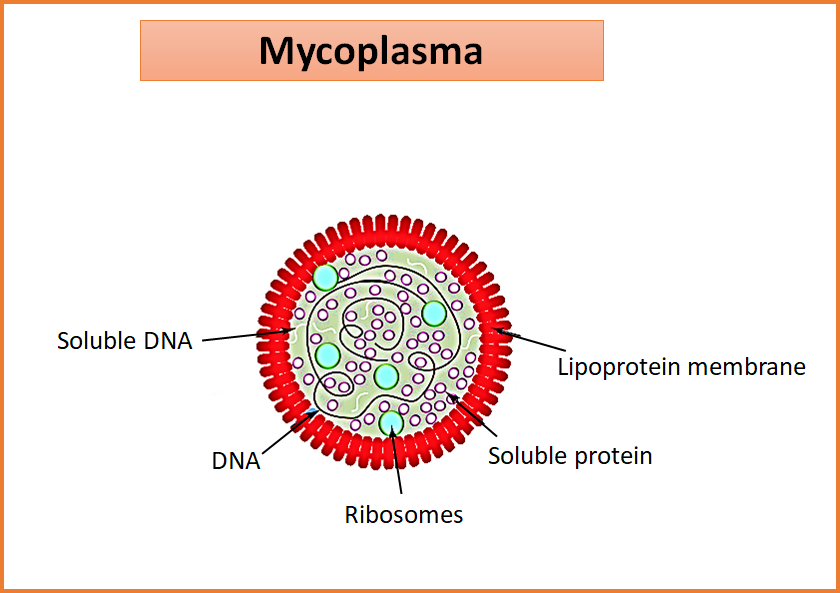
A prokaryote with linear DNA is
(a)Chlamydia
(b)Mycoplasma
(c)Bacterium
(d)Cyanobacterium
Answer
492.3k+ views
Hint: linear DNA chromosome is one with two terminal ends that aren't bound with each other into a complete ring. Bacteria and cyanobacteria both contain circular DNA with plasmid areas. Chlamydial DNA is ring-shaped with a nucleus. Mycoplasma has naked genetic material that is a singular Duplex of DNA.
Complete answer:
Most prokaryotic organisms harbor minimal genetic material or even a single DNA molecule, or a chromosome formed of circular DNA. The prokaryotic DNA is not inside the nucleus but rather is present in a central area called the nucleoid, which lacks the surrounding nuclear membrane. Many prokaryotes also carry small, circular DNA molecules called plasmids which play an important part in genetic transport.
The Mycoplasmal DNA is an exception for this as it contains an uncovered duplex strand of DNA which is linear and not ring-shaped as other prokaryotes.
Additional Information: The presence of linear DNA in eukaryotes and a ring-shaped DNA in prokaryotes suggests the evolution of Eukaryotic DNA from the Prokaryotic one, such that due to continuous mutations and repetition of genes among generations, which caused the DNA to lose the ligation property and thus prevented it to get back to a circular shape.
This supports the fact that eukaryotes are direct descendants of prokaryotic organisms.
A circular DNA is one that forms a closed loop that has no terminal edges. The examples of circular DNA are plasmids, circular bacterial DNA, mitochondrial DNA, etc.
So, the correct answer is 'Mycoplasma'
Note: In about all mammals, the mitochondrial DNA is inherited from the maternal side this is because the mitochondria from the sperm are destroyed by the ova after fertilization. Human mitochondrial DNA is double-stranded circular DNA.

Complete answer:
Most prokaryotic organisms harbor minimal genetic material or even a single DNA molecule, or a chromosome formed of circular DNA. The prokaryotic DNA is not inside the nucleus but rather is present in a central area called the nucleoid, which lacks the surrounding nuclear membrane. Many prokaryotes also carry small, circular DNA molecules called plasmids which play an important part in genetic transport.
The Mycoplasmal DNA is an exception for this as it contains an uncovered duplex strand of DNA which is linear and not ring-shaped as other prokaryotes.
Additional Information: The presence of linear DNA in eukaryotes and a ring-shaped DNA in prokaryotes suggests the evolution of Eukaryotic DNA from the Prokaryotic one, such that due to continuous mutations and repetition of genes among generations, which caused the DNA to lose the ligation property and thus prevented it to get back to a circular shape.
This supports the fact that eukaryotes are direct descendants of prokaryotic organisms.
A circular DNA is one that forms a closed loop that has no terminal edges. The examples of circular DNA are plasmids, circular bacterial DNA, mitochondrial DNA, etc.
So, the correct answer is 'Mycoplasma'
Note: In about all mammals, the mitochondrial DNA is inherited from the maternal side this is because the mitochondria from the sperm are destroyed by the ova after fertilization. Human mitochondrial DNA is double-stranded circular DNA.

Recently Updated Pages
Master Class 11 Economics: Engaging Questions & Answers for Success

Master Class 11 Business Studies: Engaging Questions & Answers for Success

Master Class 11 Accountancy: Engaging Questions & Answers for Success

Master Class 11 English: Engaging Questions & Answers for Success

Master Class 11 Computer Science: Engaging Questions & Answers for Success

Master Class 11 Maths: Engaging Questions & Answers for Success

Trending doubts
State and prove Bernoullis theorem class 11 physics CBSE

What are Quantum numbers Explain the quantum number class 11 chemistry CBSE

Write the differences between monocot plants and dicot class 11 biology CBSE

Why is steel more elastic than rubber class 11 physics CBSE

Explain why a There is no atmosphere on the moon b class 11 physics CBSE

1 ton equals to A 100 kg B 1000 kg C 10 kg D 10000 class 11 physics CBSE




